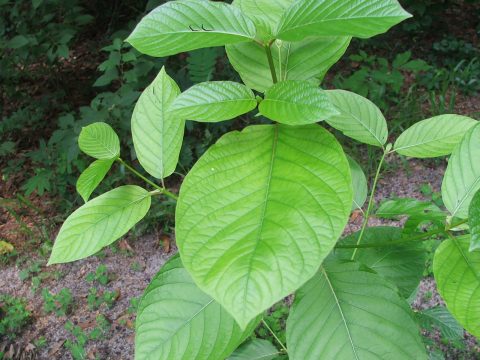
Kratom (Mitragyna speciose) is a tropical tree from Southeast Asia whose leaves are traditionally chewed or prepared as a powder. Native populations chew the leaves to reduce fatigue when doing manual labor, such as working on rubber plantations. It is also used in cultural performances and consumed as a drink prepared from kratom powder. When the Second World War caused an increase in the price of opium, Thai addicts forced to cut back on opium consumption used kratom to ease their withdrawal symptoms. Thailand and other Southeast Asian countries have passed laws controlling its use and other countries have followed suit, including Australia and New Zealand where it is banned.
In the past several years, kratom consumption has spread beyond traditional uses and the confines of Southeast Asia. In the U.S., it is widely available in head shops, kava bars, and on the internet. It is touted as a legal, psychoactive alternative to other sedative and stimulant-type drugs, both legally and illegally obtained. It is marketed for opioid and alcohol withdrawal symptoms, chronic pain and appetite reduction, among other things. There is also anecdotal evidence of naturopaths prescribing it for opioid withdrawal and depression.
According to a recent article in the International Journal of Legal Medicine from three authors based at the University of Florida’s Department of Medicinal Chemistry, College of Pharmacy, kratom’s abuse potential stems from its cocaine- and morphine-like psychoactive effects, which are dose-dependent. Exactly how kratom works in the brain is unclear, but it appears to function as a stimulant at low doses and a depressant at high doses.
Kratom is a drug of concern, for good reason
Kratom is on the Drug Enforcement Administration’s Drugs of Concern list (substances that are not currently regulated by the Controlled Substances Act, but that pose risks to persons who abuse them), and the National Institute of Drug Abuse identifies kratom as an emerging drug of abuse. Published case reports have associated kratom exposure with psychosis, seizures, and deaths. According to the CDC’s Morbidity and Mortality Weekly Report issued July 29th,
Kratom use appears to be increasing in the United States, and the reported medical outcomes and health effects suggest an emerging public health threat. Members of the public and health care providers should be aware that the use of kratom can lead to severe adverse effects, especially when consumed in combination with alcohol or other drugs. [Footnotes omitted.]
Because kratom is a botanical, it is legally classified as a dietary supplement in the U.S. However, the Dietary Supplement Health & Education Act (DSHEA) requires any supplement ingredient that wasn’t in use before 1994 to meet a minimal demonstration of potential safety. Manufacturers are supposed to submit information to the FDA showing a history of use or other evidence of safety, establishing that their product is reasonably expected to be safe under normal conditions of use. The FDA says that not only has no such evidence been submitted, but
[i]n fact, the scientific literature disclosed serious concerns regarding the toxicity of kratom in multiple organ systems. Consumption of kratom can lead to a number of health impacts, including respiratory depression, nervousness, agitation, aggression, sleeplessness, hallucinations, delusions, tremors, loss of libido, constipation, skin hyperpigmentation, nausea, vomiting, and severe withdrawal signs and symptoms.
Kratom’s questionable legal status
Had kratom made it onto the expansive U.S. dietary supplement market prior to 1994, there would be little the FDA could do to get it off the market. The burden would have been on the FDA to prove kratom is unsafe before it could be banned. The fact that it was used in Southeast Asia (as opposed to the U.S.) in a tea prior to 1994 is sufficient in the eyes of at least one lawyer on the payroll of the supplement industry to argue that it should be allowed into the U.S. and sold as a dietary supplement, potential for abuse and ill effects be damned.
On the other hand, if kratom were purified and the active ingredient(s) isolated and manufactured, (as is the case with, for example, morphine), it would have to go through the FDA’s new drug process, including randomized controlled clinical trials to establish its safety and efficacy in humans. The drug would require a prescription, and extensive literature including information on side effects, dosing, and interactions with other substances would be available for both the prescriber and the patient. Such is the fiction established by DSHEA that botanicals are somehow not drugs, even when they are taken explicitly for medicinal purposes.
Fortunately, under the circumstances, the FDA can and has banned the importation of kratom, giving authorities the right to seize shipments coming into the U.S. However, large quantities are still making their way through. In January, the FDA seized $400,000 worth of kratom in Illinois.
Increasing worries about kratom’s dangers have caused legislators to introduce bills in at least 15 states either banning its sale and possession altogether or banning its sale to minors. A handful of these bills have become law. Sarasota County, Florida, banned kratom as well, although a bill to do the same for the entire state failed this year.
Special interests raise their heads, and funds
A special interest group, the American Kratom Association (AKA) was formed to fight these efforts. They’ve hired Paul Pelosi, Jr., U.S. Rep. Nancy Pelosi’s son, as their Executive Director. Interestingly, I could find no mention of the FDA’s ban on importation on the AKA website.
The existence of the AKA tells us that there are sufficient financial interests in kratom sales to bankroll such an organization, its stated goal of supporting consumers notwithstanding. The AKA’s arguments for legality, supported by cherry-picked evidence, are centered on the usual irrelevant points made by those who sell dietary supplements: Kratom is “natural,” not synthetic, and has beneficial uses. They are correct. So are morphine and codeine, other “natural” products with sufficient concerns about misuse to regulate them as prescription drugs. Regulation as a prescription drug would also prevent kratom’s being laced with pharmaceutical drugs, a danger inherent in all herbal remedies.
In defending kratom, the AKA actually makes several points that support its being regulated like the drug it is.
- “If taken in excess, continuously over long periods of time, Kratom consumers may experience dependence, similar to caffeine dependence.”
- “There can also be some discomfort if taken daily and use is abruptly discontinued. This can be avoided by taking regular breaks and/or gradually tapering down consumption levels.”
- “Kratom products are not recommended for use by minors or for women who are pregnant or breastfeeding.”
Of course, none of this information appears on the label because warnings aren’t required for dietary supplements.
The United Natural Products Alliance acted more responsibly. Its members are prohibited from selling kratom and kratom-containing products as a condition of membership, an action taken after the UNPA reviewed the safety issues and potential for misuse. In fact, the UNPA issued a statement applauding the FDA’s seizure in Illinois. At least one dietary supplement manufacturer voluntarily recalled all kratom-containing products.
Botanicals taken for medicinal purposes are drugs and they should be regulated as drugs. Kratom is no exception. The fact that certain chemicals having pharmacologic effects on humans wound up in plants is an accident of evolution, not the result of some mythical natural beneficence.




